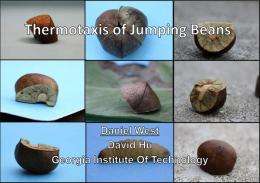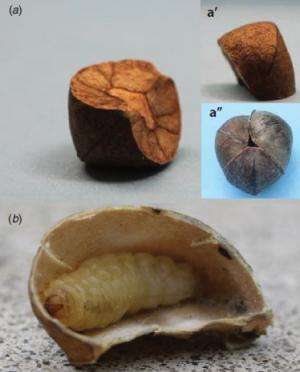June 18, 2012 feature
Mexican jumping beans may influence robot design (w/ Video)

(Phys.org) -- Most animals move around by using their appendages, such as legs, wings, or fins. But a few exceptional creatures employ rolling as a mode of locomotion. Included in this group are rolling salamanders, spiders, caterpillars, and Mexican jumping beans. In a new study, researchers have investigated the seemingly random motion of Mexican jumping beans, which are not actually beans but hollow seeds containing moth larva, and found that their motion is not entirely random. The researchers developed an algorithm of the beans’ behavior, which they then used to program rolling robots to move in a controlled direction.
The team of mechanical engineers, Daniel West, Ishan Lal, Michael Leamy, and David Hu at the Georgia Institute of Technology in Atlanta, has published their study on the rolling locomotion of Mexican jumping beans in a recent issue of Bioinspiration & Biomimetics.
Originating in the northwestern mountains of Mexico, Mexican jumping beans (Laspeyresia saltitans) begin their lives when the mother moth lays its eggs in the flowers of a native fern in early summer. When the flowers mature, they turn into pie-shaped seed pods, which split apart to entrap moth larva in sections resembling slices of a pie. Mid-summer rains cause each 1-cm-diameter seed pod section, or “bean,” to drop from the fern to the ground. To escape from the hot sun, the entrapped larva must quickly find shady areas where the temperature is cooler, and spends the next 6-8 months in the seed pod jumping and rolling around to seek out shade. As it matures, its last act as a larva is to cut a trapdoor in the seed, after which it becomes a pupa. Once the pupa transforms into an adult moth, it exits the seed through the trapdoor.
Since as far back as anyone knows, children have played with Mexican jumping beans and people have used them in games of chance due to their seemingly random motion. In 1955, the scientist K. Herter discovered how the larva controls the movement of the seed pod by placing a larva inside a transparent pill capsule. He observed the larva use silk threads to attach itself to the inside of the capsule and then move the bean by walking up the inner surface (to cause rolling) or grabbing the capsule with its prolegs and rapidly striking the capsule with its other end (to cause jumping). In the 1980s, scientists discovered a correlation between the outside temperature and the frequency and duration of the beans’ movements, which peaked at 40 jumps per minute for several minutes at 45 °C (113 °F).
To add to this knowledge of Mexican jumping bean locomotion, the researchers in the current study built a 12-lane racetrack using a metal baking pan. They placed an electric heating blanket under one end of the pan and used different heat settings to create different temperature gradients between the start and finish lines. Using beans from the professional breeder at MyPetBeans.com, the researchers performed several races with the beans and then cut them open and performed races with the larvae.

By observing the rolling, jumping, and flipping of the beans, the researchers calculated the frequency of each type of movement. Out of 550 movements, the beans jumped 85% of the time, rolled 14% of the time, and flipped 1% of the time. They noticed that this “jump-and-roll” motion closely resembles the “run-and-tumble” motion of bacteria and other organisms. Previous research has shown that this type of trajectory is optimal for locating randomly distributed targets, and the engineers hope to investigate the strategy further in the context of the jumping beans.
One more thing the researchers discovered in this study is that not all Mexican jumping beans are alike. Each bean has its own preferred temperature, and this variation is what causes some beans to move faster along the racetrack than others. The researchers concluded that, although jumping beans are used in games of chance, their individual motions can be largely determined.
Using their experimental data, the researchers wrote an agent-based algorithm of jumping bean behavior and tested its accuracy in simulations and with a wheeled robot. In both tests, the agents’ motions closely resembled the motion of the beans. The researchers explained that the programming is based on only a few simple rules: tumble randomly to the left or right, run in the direction of lowest sensed temperature, and stop moving after reaching a preferred temperature.
Insight from the locomotion of Mexican jumping beans could be useful for designing future micro-robotics with low intelligence and power needs. For example, the researchers envision designing solar-powered mechanical jumping beans, which could be used as inexpensive sensors for detecting temperature gradients. By programming the mechanical beans to respond to other gradients besides temperature (such as chemical or light gradients), researchers could use them for a variety of sensing and surveillance applications.
“Mexican jumping beans have many interesting abilities that are useful for robotics,” Hu told Phys.org. “They move within an armored shell yet still are able to sense their surroundings. Although nearly spherical, they have a notch that enables them to move uphill and across small obstacles. Finally, they implement a very simple algorithm for sensing of their surroundings that is effective for enabling them to find shadows and hide in them. All these abilities might be implemented in a much smaller robot.”
In the future, the researchers plan to further investigate rolling in other animals.
“We are interested in the tradeoffs between walking and rolling locomotion,” Hu said. “It still remains unclear why so few animals use rolling locomotion in nature. In comparison, on paved roads, rolling locomotion such as with wheels is the most efficient. We plan to investigate other animals capable of both walking and rolling.”
More information: Daniel M. West, et al. “Locomotion of Mexican jumping beans.” Bioinspir. Biomim. 7 (2012) 036014 (12pp). DOI: 10.1088/1748-3182/7/3/036014
Journal information: Bioinspiration and Biomimetics
Copyright 2012 Phys.org
All rights reserved. This material may not be published, broadcast, rewritten or redistributed in whole or part without the express written permission of PhysOrg.com.


















